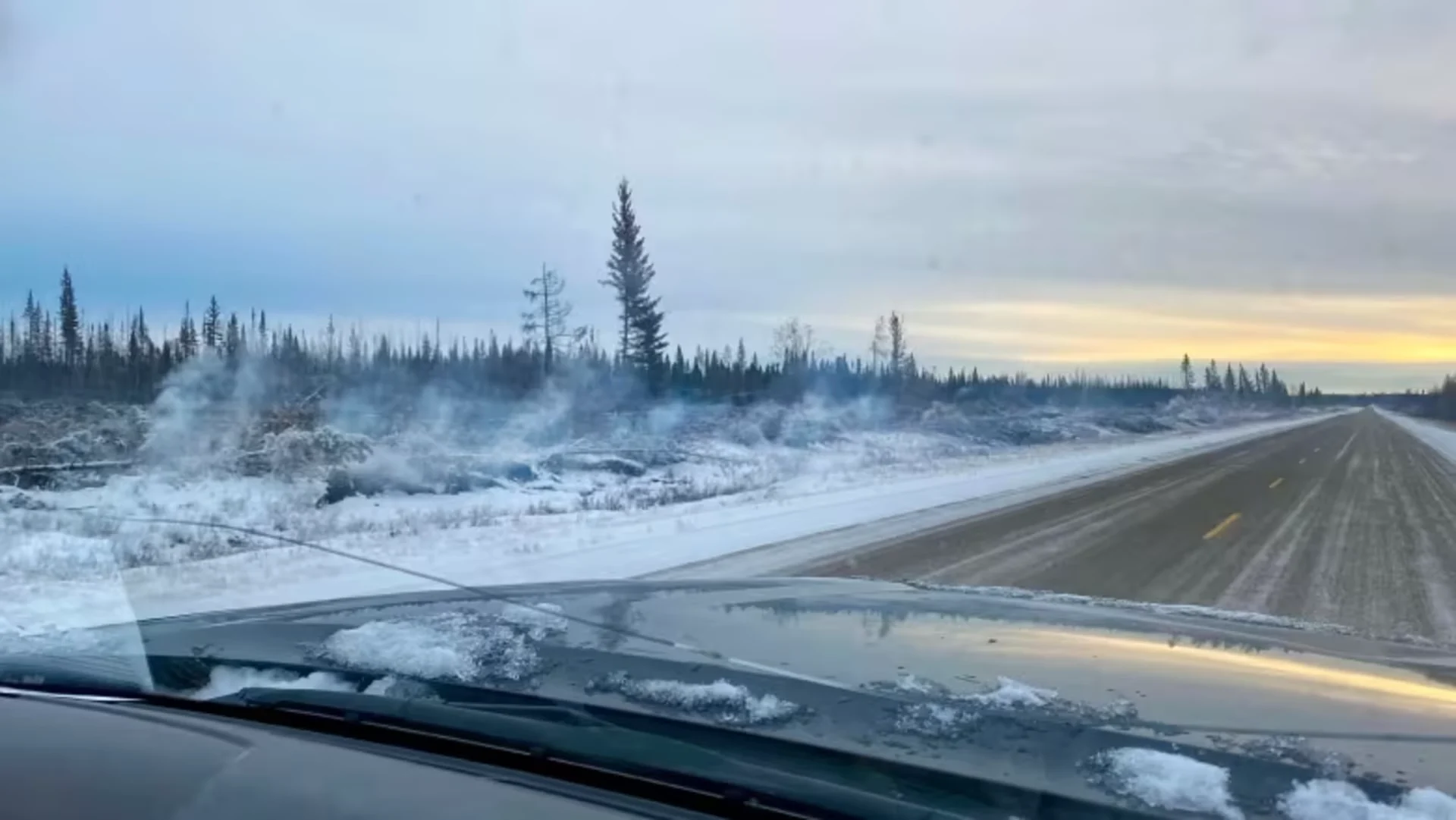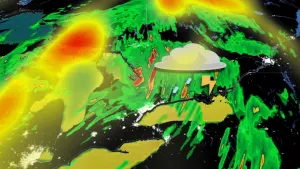
Smoking snow shows 'holdover fires' still burning in N.W.T.
Holdover fires are still burning across the N.W.T., sending smoke billowing up from snow banks along roadways, but a fire scientist says there's no need to be alarmed right now.
These fires, which burn under the surface of the ground, can last the winter, tucked under snow and ice. In the last month, their presence has been noticed by the billows of smoke drifting up from snow near communities like Enterprise and Fort Smith, in the burn zone from this past summer's fierce wildfires.
They aren't a danger at the moment, said Quinn Barber, a fire scientist with Natural Resources Canada, "notwithstanding how scary they are to see burning, especially in the winter."

Smoke drifts upward from snow along the side of Highway 1 near Enterprise, N.W.T., in early December 2023. (April Hudson/CBC)
It's when the snow melts that these fires can become dangerous, with the potential to flare up again, Barber said.
The first wildfire last year in the N.W.T. was the result of a holdover fire north of Fort Smith, N.W.T.. Fire SS019 grew to over 500,000 hectares and burned several cabins.
Barber said it's hard to predict what the holdover fires will do in the spring, but the weather over the coming months will give us an idea of what will happen.
DON'T MISS: Winter to finally show up in January as El Niño bested by polar vortex "What we need to be watching is that spring snow pack. We need to be hoping that we don't get those warm temperatures in February and March that melts that snow pack," Barber said.
He added the speed of the snow melt is also a factor.
"Rapidly, it can tend to cause flooding and overland flow and then dry out," he said. "Gradually, you're keeping the ground wet a lot longer — it can reduce that spring fire activity."
That means by February or March, as specialists continue to monitor temperature and snow pack depth, a clearer picture should emerge of what these holdover fires mean for 2024.
'Reading tea leaves'
In the meantime, Barber said they have trained meteorologists and are already keeping a keen eye on the weather patterns around the world for signs of what's to come.
"They look at everything, from what's it doing right now to what's the ocean temperature in India," he said. "They get an idea about how things are going to be a month from now, two months from now."
But none of that data is going to be as solid as the weekly forecast coming out closer to spring.
"It's really just reading tea leaves until you can see whether or not a big arctic low or a pacific high is coming over carrying a lot of precipitation," he said.
"Nobody likes April snowstorms, but if we got an April snowstorm this year, that'd be great. It definitely helps dampen that fire activity in the spring."
Barber said we are seeing more holdover fires this season than what we've typically seen in the past, though there hasn't been a lot of research published in the region on what those numbers look like historically.
"It's hard to say if it's going to break any records. They're also really hard to quantify as to what is considered a holdover fire and what is not," he said.
The region also plays a role in why we are seeing so many holdover fires this year, Barber said. The fires burn in deep duff layers and sphagnum bogs, both of which are present around Fort Smith and Hay River.
"Right now, we have enough drought that these holdover fires are able to kind of take root," he said. "It's particularly bad in the region of Hay River and Fort Smith that's been perhaps one of the driest years we've ever seen."
Preparations ongoing for next fire season
Combating these fires while active in the winter months is also not an easy task.
"They're really difficult to access. To get them and to put them out, you need to excavate them not only from the snowpack, but you need to dig down, and you need to put them out at their source," he said.
This can be dangerous for the fire crews but also very labour intensive — even if the fire in question is a small one.
"It's very difficult to figure out when they're out," Barber said. "Right now, the best thing we can do is to monitor them to keep track of them."
Monitoring the holdover fires is something the territory is currently doing. Mike Westwick, a fire information officer with the N.W.T. government, said they are already keeping a close eye on the fire situation.
"We'll use a number of different methods to detect that. We can use satellite detection, we can use surveillance flights," he said. "As well as reports from members of the public."
They also have nine towers equipped with 360-degree cameras that allow for early detection of fires and three fire towers that continue to be monitored by fire staff.
"Preparing for and responding to wildfires is a year-long job," Westwick said. "But, you know, suffice to say, we need to be ready for whatever Mother Nature throws at us. And we're doing just that right now,"
This article, written by Carla Ulrich, was originally published for CBC News.









